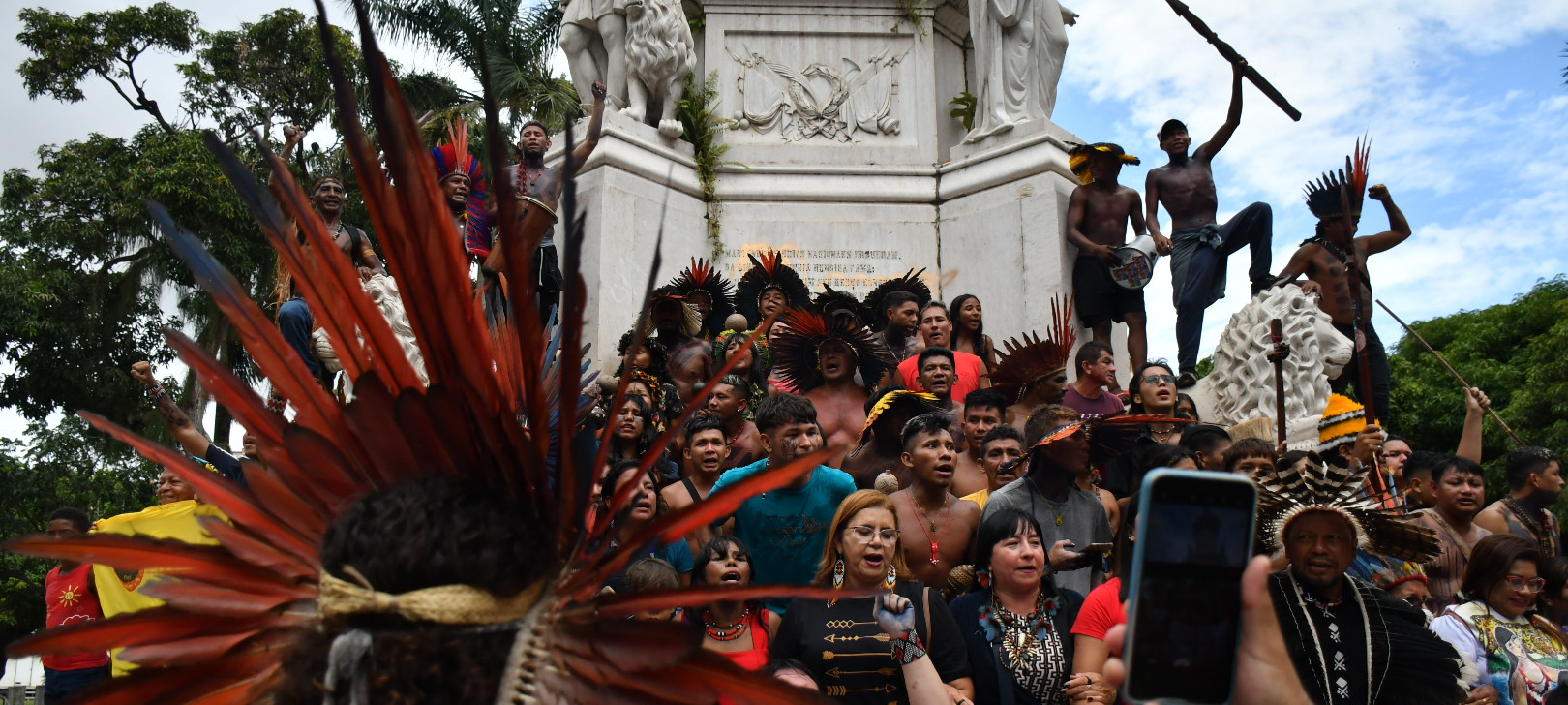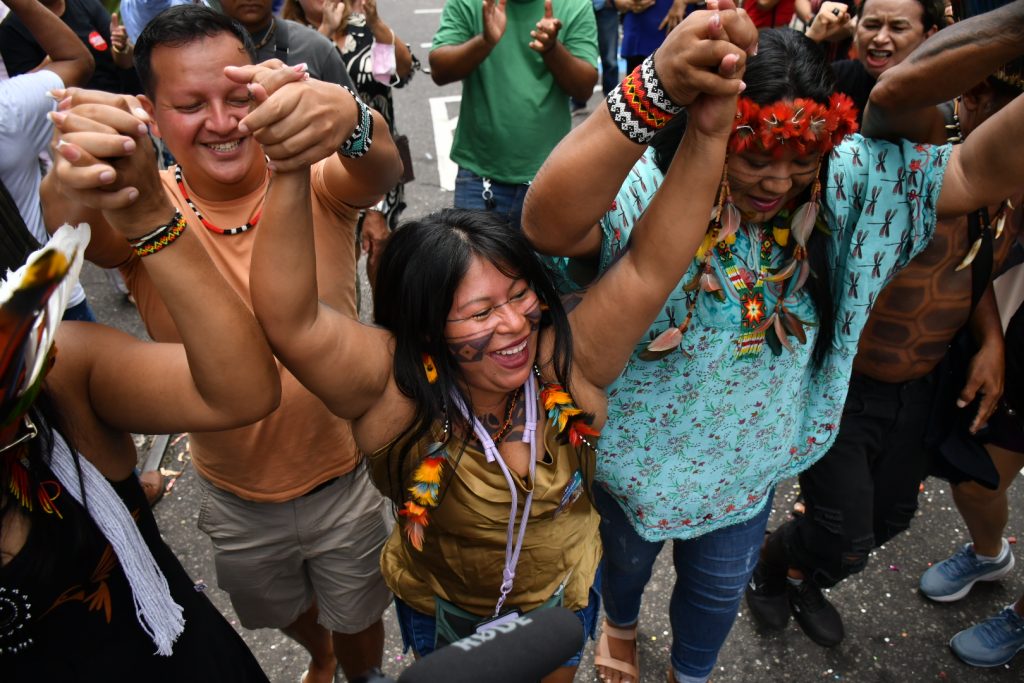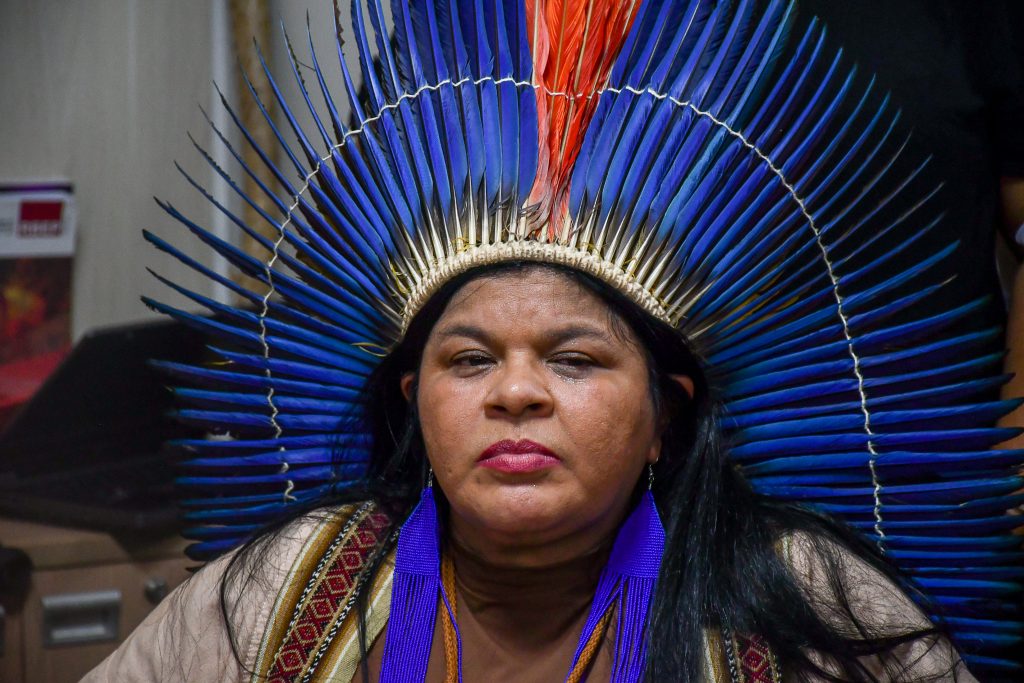SPECIAL – Ancestry against the dismantling of education in Pará
22 de April de 2025

By João Paulo Guimarães – Special for Cenarium
BELÉM (PA) – The historic victory of the Indigenous community, traditional peoples, teachers, independent journalists, and the people of Pará—who, in an unprecedented mobilisation, occupied the Pará State Secretariat of Education (Seduc-PA) for over 30 days—resulted in the repeal of Law No. 10,820/24, which stripped away rights from the Teaching Statute and dismantled the Modular Education Organization System (Some) and the Indigenous Modular Education Organisation System (Somei).
This story is just one part of the broader narrative of the dismantling that education in Pará has been suffering under the administration of Governor Helder Barbalho (MDB) and Education Secretary Rossieli Soares. The law, approved by the Pará State Legislative Assembly (Alepa), has been repealed. However, the Pará Education Media Centre (Cemep)—which replaces teachers with computers, recording studios, and Starlink antennas in rural areas—continues to advance.

During the Alepa vote, protesting teachers were met with punches, kicks, gunfire, tear gas, and arbitrary detentions. A Some teacher, who preferred to remain anonymous, described fleeing from military police officers who jumped out of a moving vehicle, wielding shotguns loaded with rubber bullets.
In the chaos, he did not immediately notice the hole in his shirt caused by a shot. He was hit by a shotgun blast in the back and another that grazed his arm. “They were about to run us over with the car, so we knocked over a rubbish container. They were forced to stop but immediately started shooting at us from behind,” he recounted.
Military police ran among the demonstrators with handguns drawn and live ammunition, pushing teachers to the ground and dragging them into the Assembly. Historian and teacher Allan Silva was also assaulted, struck in the face by a chair thrown by a police officer. “The officer came at us. I said, ‘Calm down, officer, wait.’ At that moment, another officer threw a chair at my face. I started bleeding.”
On the other side of what had become a war zone, teacher Jaqueline Cristine Sosi, 46, a cultural management specialist, saw a grenade being thrown in her direction. “At that moment, we were stunned when the bomb exploded. It feels like time freezes.” She kept a fragment of the explosive device.
In response to these events, Indigenous people from various ethnic groups across the state took the lead in the battle, occupying Seduc-PA from 14 January, facing off against the Military Police, Tactical Force, cavalry, harassment, and night-time attacks by unidentified men.
The police officers overseeing the occupation were accused of committing sexual harassment and psychological terror during the night, spraying pepper spray in the toilets and prohibiting access to the press and the Human Rights Commission of the Brazilian Bar Association (OAB-PA).

The occupation received support from various regions of Pará, with caravans organised by local communities. Chief Miriam Tembé, 41, travelled from the I’ixing Village in Tomé-Açu, alongside members of the Amarqualta Quilombola Association, to support the movement until the repeal of Law No. 10,820. “This law violated the rights of all our relatives in the region because it concerns Indigenous school education. If it violates the rights of one, it violates the rights of all,” she declared.
Indigenous leaders accused the state government’s Secretariat for Indigenous Peoples of neglect and abandonment. The Secretariat’s secretary, Jacqueline Alves dos Santos, known as Puyr Tembé—who was supposed to act as a bridge between the movement and Governor Helder Barbalho—failed to fulfil this role.
During the first ten days of the occupation, the Ministry of Indigenous Peoples, in a meeting with Minister Sônia Guajajara, aligned itself with the Pará government by proposing the creation of a new law for Indigenous education, abandoning the demand for the repeal of Law No. 10,820/24.
Fight Against Disinformation
On her social media, Sônia Guajajara posted a video with information contradicting what had been discussed with the movement, adopting the state government’s proposal even after being informed, in a meeting with Indigenous leaders, that the central demands of the occupation were the repeal of Law No. 10,820 and the dismissal of the Secretary of Education. The minister was contradicted in her post by key Indigenous leaders and supporters of the movement.
Upon arriving at the occupation, Guajajara limited herself to responding to criticism on social media. She blamed independent journalism for promoting disinformation and for “exposing” the Indigenous people camped there. Accompanied by federal deputy Célia Xakriabá (PSOL-MG), the minister mediated a meeting with Governor Helder Barbalho. The Indigenous representatives were received under heavy police presence—more than 2,000 security agents—and were prevented from using mobile phones or recording the meeting, which ended without an agreement.

Despite the lack of support from the federal government and the attacks promoted by Helder Barbalho—who daily posted fake news and interviews containing false information about the occupation—public opinion understood the real reasons that led Indigenous and non-Indigenous teachers to occupy the Secretariat of Education. The mobilisation gained support on social media, with donations and expressions of solidarity from across the country.
The Federal Public Defender’s Office (DPU) filed a Public Civil Action against the State of Pará, the National Foundation for Indigenous Peoples (Funai), and Meta, the company responsible for Facebook and Instagram, demanding the removal of posts made by Governor Helder Barbalho that spread disinformation about the Indigenous mobilisation. According to the DPU, the posts falsely claimed that the Indigenous occupation had been motivated by fake news about the end of in-person education in Indigenous villages, whereas official documents indicated plans to implement technology-mediated teaching.
“The movement started from a piece of disinformation, claiming that we were ending the system of in-person education in Indigenous villages and replacing it with a distance education system. Something that has never existed and never will. Fake news,” stated the governor in a video that the DPU requested be removed.
The DPU argued that the governor’s posts distorted reality and discredited the Indigenous struggle against the repeal of the Indigenous Modular Education Organisation System (Somei), potentially generating prejudice and hostility towards the demonstrators. The petition emphasised that Indigenous people had a “justified fear” that the abolition of the legislation regulating Somei was a step towards introducing distance education, especially after the Department of Education confirmed in an official document to the Federal Public Prosecutor’s Office (MPF) that technology-mediated teaching would be implemented in the Parakanã Indigenous Land in 2025. “The statement by His Excellency the Governor is a lie and seeks to create a narrative in which Indigenous people were deceived into fighting for other interests,” the action stated.
In addition to the removal of the posts, the DPU requested that the State of Pará and Meta allow Indigenous people to publish a right of reply on the same platforms, ensuring the correction of the official narrative. It also asked that Funai take measures to protect the honour and integrity of Indigenous communities by combating the spread of false information.
The action further demanded R$10 million in compensation for collective moral damages, to be allocated to the affected Indigenous communities. The DPU maintained that the governor’s statement not only misinformed but also delegitimised a legitimate mobilisation, violating fundamental rights. “The declaration sought to portray Indigenous communities as incapable of understanding the consequences that legislation rushed through in a ‘hasty manner’ could have,” the petition stated, highlighting that the government was attempting to manipulate public opinion against the demonstrators. The case was heard in the Federal Court, which analysed the request for an injunction to immediately remove the posts and for a public retraction from the state government. Read the full document:
Retaliation and harassment
A group of 14 teachers from Conceição do Araguaia, 933 km from Belém, who had travelled to support the occupation, were removed from their schools despite the State Prosecutor, Ricardo Sefer, having promised that no action would be taken against the protesting teachers. Days after the meeting with Rossieli Soares, the group received emails informing them of their removals from their schools and from Some.
Teacher Irisleide dos Santos Sirqueira was present at the occupation of Seduc Pará and remained there for nearly 40 days. In one of the few meetings in which Rossieli Soares participated with Indigenous people and teachers, she explained to the secretary that the entire organisation of the occupation had originated in Conceição do Araguaia. Irisleide stated that she had already anticipated the retaliation. “Our removal happened five days after my statement in the meeting with Rossieli,” she said.
The Government of Pará backtracked and revoked the removal of the 14 teachers following intense pressure from the profession and reports on social media denouncing the removals as retaliation. The movement for education in Pará continues to gain strong support and engagement on social media, as well as from education professionals across the country. Read the full document:
The topic was featured on the cover and as a special report in the latest edition of CENARIUM MAGAZINE. Click here to read the full content.


